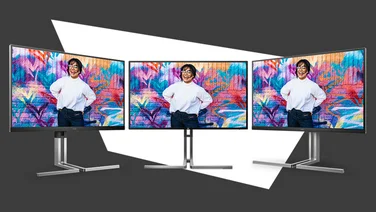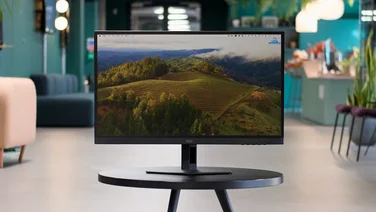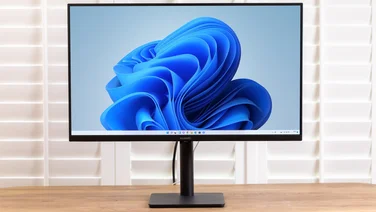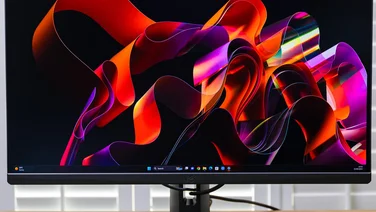To help us provide you with free impartial advice, we may earn a commission if you buy through links on our site. Learn more









- Cracking gaming performance
- PureXP motion blur reduction
- Bright and accurate panel
- Limited HDR performance
- Deep stand
The ViewSonic Omni XG2431 is one of a vast number of pint-sized gaming monitors with an esports skew. To help you gain the competitive edge it has a 240Hz refresh rate backed by motion blur reduction technology that earns a seal of approval from Blur Busters, the renowned home of anything related to panel performance (and the source of our in-house motion handling tests).
The Blur Busters stamp of approval relates specifically to the PureXP backlight strobing tech that the XG2431 uses to reduce motion blur (or optimise moving picture response time, or MPRT as ViewSonic prefers to describe it). Forget adaptive sync, on a fast monitor (MPRT really only comes into its own above 100Hz) this is the technology you really need.
This isn’t the first ViewSonic monitor to feature PureXP but it is the smallest and cheapest and now, a year after it was released in North America, you can finally buy it here in Blighty.
ViewSonic XG2431 review: What do you get for your money?
ViewSonic has a reputation for delivering some of the best-made monitors on the market and the XG2431 shows why. For a cheap monitor it’s extremely well made, with no squeaks, creaks or groans evident when you manhandle the plastic display body. The base is equally solid and well made. All in the package weighs just shy of 7kg, with the stand accounting for half of that.
This is a 24in IPS panel with a resolution of 1,920 x 1,080, a maximum refresh rate of 240Hz and a quoted response time of 1ms G2G. The XG2431 naturally features adaptive sync and is certified by the AMD FreeSync Premium scheme but not under Nvidia’s G-Sync Compatible alternative, though it worked perfectly well with my RTX 3060 graphics.
ViewSonic clearly has no truck with these new-fangled quick-release mechanisms because the XG2431’s stand is fixed to the back of the panel with four bolts. The stand is fixed in place at the factory so it’s no hardship, though it does of course mean that you’ll need to unbolt it if you want to fix it to an existing 100 x 100mm VESA mount.









The XG2431 is typical of ViewSonic’s rather no-frills styling, with impressively thin bezels of just 6mm around the top and sides and 19mm at the bottom. Those slim side bezels will pay dividends should you decide to buy two screens for side-by-side use. The OSD control buttons all sit in a row below the right-hand corner.
There’s plenty of adjustment on offer, including a 90° left and right swivel (a by-product of the swivel mechanism being where the stand meets the base rather than where the monitor meets the stand), 90° clockwise rotation, 120mm of height adjustment and -5°/15° tilt. The swivel base does have one negative in that it makes the footprint unusually deep at 230mm from front to back, thanks to most of the circular swivel housing protruding from the back of the otherwise oblong base.
READ NEXT: The best monitors for work and gaming
ViewSonic XG2431 review: What type of connections does it have?
The port selection is good rather than exceptional. Along with two HDMI 2.0 and one DisplayPort 1.4 video inputs there’s also a Type-B 3.2 Gen 1 upstream USB port and two downstream Type-A 3.2 Gen 1 ports and a 3.5mm audio output. That’s a perfectly decent range for a gaming monitor, although in the absence of a Type-C upstream you’ll need to connect your PC with the (supplied) Type-B cable to connect any peripherals to the monitor’s USB hub.









ViewSonic XG2431 review: How good is the image quality?
When it comes to everyday SDR dynamics the XG2431’s 1,920 x 1,080 IPS panel performs well. Maximum brightness is a useful 346cd/m² and the contrast ratio a solid 935:1. There’s decent colour gamut coverage, too, with 96.9% sRGB, 70.2% Adobe RGB and 73.4% DCI-P3. Those last two could be wider, but on a £300 gaming monitor you need to temper some expectations. In sRGB mode, the panel was surprisingly accurate, too, with a Delta E variance of just 1.08, while the uncalibrated gamma came in exactly on 2.2.
I discovered no issues with display uniformity, with the brightness levels appearing entirely uniform to the naked eye. Running a colourimeter over the panel in a 5 x 5 grid did show up some small variances, with the top and bottom bands only falling within Nominal Tolerance rather than the Recommended Tolerance that the central 3 x 5 swatches managed, but as I say, that’s not something you’ll ever notice.









The XG2431 carries a VESA DisplayHDR 400 certificate, but as with any IPS panel with no form of local area dimming that doesn’t mean a whole lot. Dynamic contrast boosts peak brightness to 520cd/m² but black luminescence remains a typically IPS-high 0.5cd/m², which kneecaps HDR contrast. Compatible content does look more saturated in HDR mode, which suggests that ViewSonic has paid some attention to making the colour gamut look wider than it is by oversaturation – an effort that definitely leaves games such as Doom Eternal and Halo Infinite looking more sumptuously colourful.
What really separates the XG2431 from the herd is the PureXP backlight strobing motion blur reduction system. In the XG2431 the system has reached such a peak of performance that it has earned a new 2.0 level of approval from the folks at Blur Busters. ViewSonic claims response times of less than 0.5ms MPRT and 1ms GtG.
PureXP takes motion clarity in affordable gaming monitors to new levels (just as long as you are happy to forgo adaptive sync, HDR and manual brightness adjustment, none of which work with PureXP engaged) and the results are impressive, with motion blur and ghosting all but eliminated at higher refresh rates.









The strength of the PureXP effect can be adjusted between four settings but each one has an effect on brightness; in short, the stronger the effect, the lower the panel’s brightness. I found putting PureXP into Normal was the best trade-off between a noticeable impact on ghosting without pushing the brightness down too far. For the record these are the brightness levels I measured at the various PureXP settings: Off (350cd/m²), Light (202cd/m²), Normal (152cd/m²), Extreme (102cd/m²) and Ultra (51cd/m²). As you can see, anything below normal can only really be used in a dark environment.
If you download the ViewSonic Blur Busters Strobe Utility and connect your PC to the monitor via USB you can adjust the PureXP settings on a more granular level to get just the effect you’re after.









I should make it clear that the backlight strobing that drives PureXP does introduce flickering, but this is invisible to the human eye and certainly beyond my ability to detect so long as the monitor refresh rate was set to 100Hz or higher. That said, users sensitive to screen flicker might experience some negative side-effects – such as headaches – after prolonged use.
Tucked away in the menus are some useful gaming features including black stabilisation, which improves visibility in darker scenes by altering the gamma curvature, three response time overdrive modes and various picture presets for FPS, RTS and MOBA gaming. Working out which features preclude the use of others is a fun way to spend a few hours. Other common gaming options such as crosshairs and an FPS counter are noticeable by their absence. For non-gaming activities, there are also Movie, Monochrome, Web, Text and Mac settings, as well as a Standard picture mode.
READ NEXT: The best gaming monitors
ViewSonic XG2431 review: Are there any other features I should know about?
In a surprising turn of events, the brace of 3W speakers built into the XG2431 turned out to be rather good. They’re reasonably loud, peaking at 73.6dB(A) against a pink noise source at a 1m distance, and though there’s not an awful lot of bass in evidence the sound they make is very tight and punchy and impressively spacious, making them eminently usable for gaming. They don’t perform too badly when listening to music, either, with plenty of detail in evidence.









Other useful features include an extendable headphones hook on the top of the stand and a removable plastic cable clip to keep your desk cable tidy. On the rear of the display on each side are two mouse anchors into which you can push your mouse cord to prevent cable dragging. It’s an excellent idea, but the thick and stiff USB cable that came with my SteelSeries Aerox 3 didn’t sit too comfortably in the rubber channels, necessitating some rather forceful pushing to keep it in place.
The OSD (on-screen display) menu is fairly sensibly organised and, although the five hotkeys placed at the bottom bezel aren’t as easy to use as a joystick, the presence of an on-screen indicator telling you what each button does in any given circumstance makes navigation an error-free process, as does the fact that the power button at the far right is significantly larger than the navigation buttons next to it. The only clunky aspect is that you’ll need to switch back and forth between several menu levels to disable and enable FreeSync and PureXP.
READ NEXT: The best 1440p gaming monitors
ViewSonic XG2431 review: Verdict
For around £400 the new XG2431 is a cracking monitor. The panel has more than enough basic competence to work as a day-to-day display for any home office and the built-in speakers are much better than I’ve come to expect at this price level.
It’s the gaming performance that sets it apart, though. Good though the 240Hz refresh rate and 1ms response times are, it’s the PureXP blur reduction that really sells the XG2431. The ability not just to minimise but effectively remove ghosting is something all gamers surely aspire to, not just hardcore esports professionals, and that’s exactly what the XG2431 delivers. Granted, PureXP removes your ability to adjust the brightness and run adaptive sync, but that I can live with if the return is the very sharpest gameplay.







